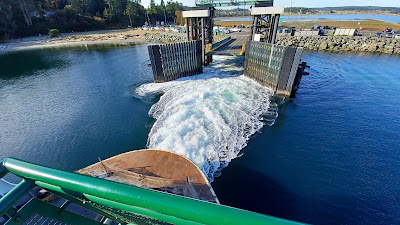Thirsty, Too!
As the water crisis, and indeed it appears to be turning into a crisis, continues, California is far from alone in its woes (one interesting fact about its almond industry, which supplies 4/5 of the world's almonds, is that elimination if that one industry alone would supply enough water to quench the thirst of 75% of California's population, according to The Week). Across the world, the situation is similar with misplaced crops developing into huge industries that become so powerful that they become subsidized and sustained by governments, despite their inefficiency.
One other example of this entrenched type of water usage came from Hawaii where early plantation owners diverted water from streams to feed their thirsty crops of sugar cane and pineapple. Huge investments were made to build irrigation tunnels and reservoirs to bring water from the wet side of the islands to the dry sides (this continued even with public works projects, as can be seen in irrigation canals stamped with the CCC, Civilian Conservation Corps, stamp). The complicated part of this "water grab" was the belief by the early Hawaiians that water can't be owned, that it belonged to everyone. But as the winter quarterly issue of Earthjustice wrote, "This takeover of resources eventually led to the unlawful overthrow of the Hawaiian Kingdom in 1893 by plantation barons conspiring with the American government. Soon after, federally appointed territorial judges began changing Hawai'i's laws to redefine water as private property to be bought and sold." But now, a century later, the Hawaii Supreme Court has ruled that "the plantation-era courts distorted the original intent of Hawai'i's water laws and that water was always a public trust resource." Says Earthjustice, "This 'public trust doctrine' was later enshrined in the state constitution and water code." In many areas of the different Hawaiian islands, streams are beginning to flow once again.
If control of water sounds familiar, you're in good company simply by visiting one of 845,000 dams in the world, all of them holding back some 48 trillion cubic feet of water. These dams "tame" nearly half of the world's largest rivers, including the Three Gorges Dam in China that flooded and buried 13 cities, 140 towns and 1,350 villages, according to Discover. The arguments for and against the control of water continues, and the figures are often disputed (even among almond growers, the number of gallons said to be needed to produce almonds varies from a low of 1.1 gallons per almond to the figure I reported, one which is more accepted among consumer groups), one side pointing to the hydropower created (thus reducing the use of coal pollution) and the other pointing to the damage and limitations to fish as well as freshwater flows to and from the ocean.
The amount of water on earth, of course, never changes. The placement of that water certainly moves, as oceans dry up and land masses rise up and ice sheets come and go and more with the times, the winds and storms move almost as freely as the shifting ocean currents. And, as Popular Science wrote, "Water is complicated...first, there is no alternative...water cannot be replaced." That magazine devoted an entire issue to that of water.
So with such a shortage looming what can be done (the drought in Colorado now enters its 14th year and officials aren't waiting, their $1 billion project slowly drilling a new intake tunnel 200 feet below the old ones at Lake Mead, a lake which some expect to be so dry in a year that there won't be enough water to even reach the current intake tunnels)? Land is actually sinking in some parts of central California due to excessive draining of aquifers, sinking as much as several feet and leading to over $1 billion in repair bills to infrastructure such as bridges and foundations (some believe this might be part of the increase in earthquakes now happening in southern California). Some aquifers are becoming polluted. And the bill to pay for all of this is virtually non-existent. As one outside water consultant from Israel noted, "A third of the counties in America still charge a flat rate for water, whether you are a business or resident, you pay a flat rate. Like $9.99, it's all-you-can-eat water." Even in my area, grandfathered plots of land mixed within the city are basically encouraged to use their water share or lose it the coming year, which leads to a purposeful (and often unnecessary) flooding of their 20 or so acres. One person told of someone living in the desert in southern Utah, who now had to bring in dirt and grass and create a lawn and garden (or he could simply let the water run off into the desert) or lose his allocation of water.
With such archaic laws and agricultural practices still on the books, it is difficult to see how the water situation will resolve itself unless pricing changes occur, leaks in delivery lines are plugged, and water becomes a commodity that is valuable and not something to waste. But yes, there are possible solutions appearing and some are already in active use, from desalinization plants (expensive) to tiny sensors placed on residential pipes to active recycling and reusing of water to growing plants with almost no water (aeroponics). Bear with me, part three of this water segment will hopefully show a glimmer of hope on the horizon, all coming in the next post.




Comments
Post a Comment
What do YOU think? Good, bad or indifferent, this blog is happy to hear your thoughts...criticisms, corrections and suggestions always welcome.